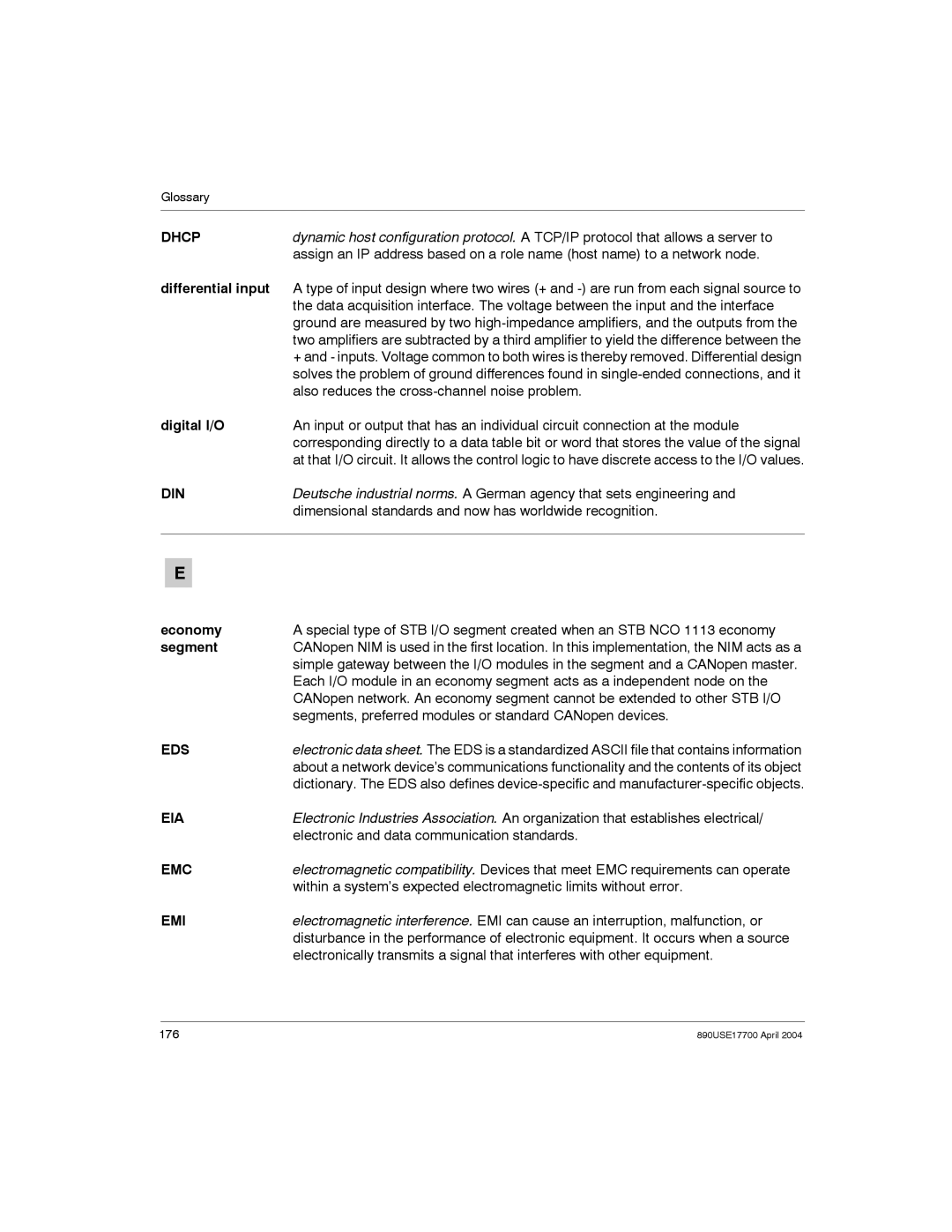Advantys STB
890USE17700
890USE17700 April
Table of Contents
IP Parameters
STB NIP 2212 Web Server
Connection Example
Advanced Configuration Features
Data Exchange
890USE17700 April
Important Information
Safety Information
Procedure
Schneider Electric. All Rights Reserved
Who Should Use This Manual?
About the Book
At a Glance
Validity Note Related Documents
Title of Documentation Reference Number
Topic
Introduction
Introduction Whats in this Chapter?
What Is a Network Interface Module?
Purpose
Fieldbus
Network
Introduction
Structural
What Is Advantys STB?
Introduction
Island Bus I/O
Primary
Extension
Segments
Island bus can support as many as six extension segments
Segment
Preferred
Modules
Standard
CANopen
Devices
Length
STB NIP 2212 Product Overview
Introduction
Ethernet Communications and Connectivity
TCP/IP
Introduction
STB NIP 2212 NIM
Summary
External Features of the STB NIP
Features NIM operations are located
Feature Function
Island’s Logic Power Bus, p to the NIM
An RJ-45 See STB NIP 2212 Network Interface, p
Server, p
STB NIP 2212 Network Interface
Fieldbus interface is also called the Ethernet port
Used to connect the STB NIP 2212 to the Ethernet baseband
Ethernet Port
Cable
Connector
Communications
Rotary Switches
Physical
Description
Represents the ones digit
Settings
Valid IP Address
LED Indicators
Front bezel
Ethernet LAN and the Ethernet port are healthy and alive
Ethernet LAN
Ethernet Communications LEDs
Advantys STB Communications LEDs
Label Pattern Meaning
ERR red
Configuration, p error
Advantys configuration software or an HMI panel
Parameter Valid Values Factory Default Settings
CFG Interface
Flap on the bottom front of the NIM
Parameter Description
Located at the bottom left of the module
Power Supply Interface
Male two-pin connector illustrated below
Right
Connectors
Use either
Logic Power
Power
External Source
Improper Galvanic Isolation
Logic Power
Flow Power and sends it across the primary segment
Improper Galvanic Isolation
NIM PDM
Telemecanique and, in the United States, from Square D
Suggested
TSX SUP 26 W, TSX SUP 1021 53 W, TSX SUP 1051 120 W, or
Module Specifications
General Specifications
Http
STB NIP 2212 NIM
Configuring the Island Bus
Auto-Addressing
Exchange and require island bus addresses
About the Island
Bus Address
An Example
Module Physical Location Island Bus Address
Bus Location
Auto-Configuration
Configuration
About Auto
Customizing a
Contamination
Installing the STB XMP 4440 Optional Removable Memory Card
Loss of CONFIGURATION-MEMORY Card Damage or
Step
Installing the Card
Use the following procedure to install the card
Step Action Open the card drawer
Edit Mode
New island is in edit mode
Overwritten
Data are ignored
Reconfigu
Configuring
Initial
Ration Scenarios
Description, p , and behind the same hinged cover
Edit mode
RST Button
Unintended Equipment OPERATION/CONFIGURATION Data
Configuration Function to configure your island Scenarios
RST Functionality
RST button See The RST Button, p causes the island bus to
Default Values
Overwriting
Flash Memory
With Factory
Configuring the Island Bus
IP Parameters
MAC-based default IP address
How the STB NIP 2212 Obtains IP Parameters
Address. The IP address can be
Assigned by an Internet server
Media Access
Deriving an
IP Address from
Control MAC
Configured
MAC-Based
IP Address
Example
IP Address Checks to determine an IP address
IP Address Assignment Process
Determining
Internal positions See Rotary Switches, p
Formats. Ethernet II is the default
Software
Priorities
STB NIP 2212 Web Server
Section Topic
Introduction to the Embedded Web Server
Introduction Whats in this Section?
About the Embedded Web Server
Accessing STB NIP Web Site
Use the following steps to access the STB NIP 2212 web site
STB NIP 2212 is configured
Properties Web
Sample
Properties Web
Web Server Configuration Options
Configuration Web
Configuration menu appears in the following figure
Configuration Options Accessing Menu
Is linked to a menu option
Configured IP Web
Configuring an IP Address for the STB NIP
Configured IP address is set up on the Configured IP web
IP Parameters Using Command Buttons
Assigning a Configured IP Address to the STB NIP
Reboot Option, p
Step Action Comment
Position See Physical Description, p
Restoring Default Parameters from the Web
Configured IP Web Page, p opens
Reboot Option
About
Configuring Master Controllers
Field Name Description
Setting Up Master Controllers for the Island
Controller Web
Master Configurator Web
Fields on the Master Configurator Web
Configuring a Master Configurator for the Island
Master Configurator Web Page, p
Field Legal Values Description
Configurator Web
Configuring a Role Name
Three numeric characters, e.g., STBNIP2212002
Sample Role Name web page is shown below
Role Name Web
Configuring a Role Name
Server-Assigned IP Addresses, p
Default IP parameters. Use the following steps
Name
Web Server Security
Password
Web Access Password Protection
Default User
STB NIP 2212 Web Server
Properties Web Page, p is
Setting Up Web Access Login
Navigate to your url http//configured IP address
Configuration Password Protection
Introduction Set Configuration Password Procedure
See Configuring a Role Name, p
Write protection for your web site is Restored
Advantys
Passwords Site, and vice versa
Synchronizing
Web Server Diagnostic Options
Diagnostics Web
Diagnostics
Diagnostics menu appears in the following figure
Menu Accessing Diagnostics
Ethernet Statistics
Using Command Buttons
STB NIP 2212 Registers Web
By their Modbus register addresses
Design
STB NIP 2212 Web Server
Data Values Web
Processes
Modules STB DDI 3610s and/or STB DDO 3600s, STB AVI 1270s
Modules can be represented on the I/O Data Values web
Values Web
Sample Island
Island Configuration Web
Configuration Web
Island Parameters Web
Error Log Web
Reported on the Error Log web
Following table
Error Log
Operations
Snmp Services
Snmp Device Management
Snmp PDU
Configure Snmp Web
Introduction Fields on the Configure Snmp Web
Purpose Field Name Description
Snmp manager can read the MIB objects for your
106
About the Schneider Private MIBs
Information Base
MIB
Schneider
TFE Subtree
Transparent
Factory Ethernet
Service Description
Transparent Factory Ethernet TFE MIB Subtree
Transparent Factory Ethernet
TFE MIB
Objects and OIDs used by a TFE service
Service Indication for Port Available Values
Port502 Messaging Subtree
Port502 MIB
Activity
Service Indication Available Values
Web MIB Subtree
Service Description Comment
Indicators, p
Equipment Profiles Subtree
Introduction Equipment Profiles MIB Subtree
Snmp agent
114
Data Exchange
Process
Data Exchange with the STB NIP
Data Exchange
Data and Status
Objects
Types
Input modules or writes to the output modules
I/O modules have the following island bus addresses
Model Module Type
119
Analog output module uses two contiguous registers
PDM short
Short in group
STB DDO 3600 status
Data Exchange Register
Reading Diagnostic Data
Are described below
Master Devices
On the STB NIP
Condition
Island
Status
127
Register
Associated location
Memory. Each bit represents one configured location
Node
130
Emergency
Messages
Modules on the island. Each bit represents a module
Queued for the associated module
132
High byte-all Advantys STB NIMs
Modbus Commands Supported by the STB NIP
Modbus
Message Data
Frame
List of Supported Commands
Ethernet Statistics, p
Word No. in Buffer Description Comment
Issued, and the statistics are retrieved
Statistics
Modbus Error Codes
General Error Codes
Error Code Error Type Description
Displayed as byte codes in hexadecimal format
138
Connection Example
Overview
TCP/IP is an open protocol
Network Architecture
Type of Connection Cabling Guidelines
By Schneider Electric
Network Interface, p
Sample Configuration
Configuration
Model Module Type Module’s Island Bus Address
N3 status
45407
AVI 1270 channel 2 status 45408
AVI 1250 channel 1 status 45409
AVI 1250 channel 2 status
Modbus Functions Supported by the STB NIP
Request
Response
Reference
Descriptions
Indicate an error condition
List of Supported Function Codes Their Descriptions
Modbus over TCP/IP Data Exchange
Statistics, p
Advanced Configuration Features
STB NIP 2212 Configurable Parameters
Accessing Configurable Parameters
General
Information
151
Reserving Data
Sizes
Must reserve space for that data. To reserve data sizes
Assigning
Mandatory
Configuring Mandatory Modules
Specifying
Mandatory Stop
CONFIGURATION-RST Button While Recovering from
Unintended Equipment OPERATION/LOSS
Limitations
Prioritizing a Module
Than other island modules
What Is a Reflex Action?
How Reflex
Actions Behave
Unexpected Output Operation
Configuring a
Reflex Action
Inputs to a Reflex
Action
Reflex Action Result Action Module Type
Nesting
Block is an operational input to the second block
Table above
First nested action
Number of Reflex
Blocks on an
Blocks
On an action module
Heartbeat
Island Fallback Scenarios
Fallback
Functions
Fallback States
For Reflex
Saving Configuration Data
When you attempt to save it
Protecting Configuration Data
Feature
Characteristics
Protection
Modbus View of the Island’s Data Image
Registers
Their Bit
Displayed as the rightmost bit in the register
Block
167
Process Image
Island’s Process Image Blocks
Output Data
Read/Write
Capabilities
HMI Blocks in the Island Data Image
HMI Panel
171
172
Glossary
ARP
BOS
Can
COB
Coms
CRC
DIN
EDS
EIA
EMC
EOS
Fedp
Frdp
Fsdp
Gateway
Program or /hardware that passes data between networks
GlobalID
Devices on the network
Base
Scanning
IEC
IEC type 1 input
Interbus
Energized and open when the coil is energized
Energized and closed when the coil is energized
Contact
Nema
NIM
NMT
PLC
PDM
PDO
RTD
SAP
Scada
SDO
Selv
Smmps
Snmp
TFE
Stdp
TCP
UDP
Varistor
Suppress transient voltage surges
Voltage group
Diagnostics menu
Index Numerics
Index
191
192
193
194

